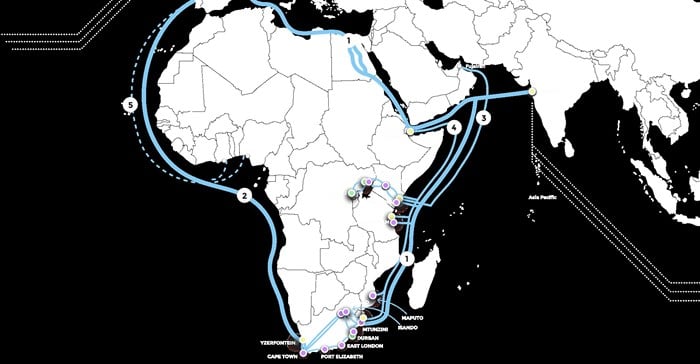
Africa is served by a network of undersea internet cables
“Liquid Intelligent Technologies confirms that multiple undersea cables operating along Africa’s West coast are experiencing outages around the Abidjan area; the exact location and reason are being investigated,” said a spokesperson in a statement.
“Our investment in multiple undersea cables along the East and West coasts has allowed us to carry traffic with minimal disruption.”
Prenesh Padayachee, Seacom group chief digital officer, was more forthcoming with information and took the opportunity to give an update on the Red Sea situation.
What are the effects of the recent cable breakages on Seacom clients?
Our clients are fortunate to have built-in redundancy. Their IP traffic is automatically rerouted, meaning the break is mostly transparent to the end-user barring a potential slight increase in latency.
How does the company manage to stay ahead of competing service providers?
We invest in infrastructure upfront and were the first to go live on Equiano cable and actively participate in new cable projects like. The company also builds in multiple redundancy layers, both for the subsea network and within national terrestrial networks.
Can you offer guarantees to clients during disruptions, especially as redundancy is now more strained and prices rise?
We are fortunate to not need to manually reconfigure its network, as traffic automatically reroutes to the next available path. This is a key differentiator. While some providers – specifically the high bandwidth hyperscalers – with capacity mapped to specific cables see performance suffer, we maintains reliable service for clients. We saw this happen with the Microsoft clients who couldn’t access teams.
What are the contingency plans employed when routing is disrupted?
The main principle is upfront investment in multiple cable systems and terrestrial redundancy. We use dual routing for traffic that needs to head to Eastern or Western Europe and use the geographically appropriate cable to follow the shortest possible routes and optimise use around load shedding schedules (in South Africa specifically) to further protect their network.
Do you have any advice for businesses choosing ISPs to mitigate these kinds of outages?
If the price seems too good to be true, it probably is. Look at a potential ISP's infrastructure and ask:
• Who provides their international capacity?
• Which cable networks do they have access to?
• Does traffic automatically reroute in case of an outage?
Unknown fault specifics
Padayachee also explained that, while this is one of the worst disruptions he has seen, he was joking with colleagues that they have seen this movie before.
Regarding the Red Sea outage, the suspicion is anchor drag damage and not vandalism that has been reported – and he could see the same issues happening on the west coast of the continent.
Red Sea repair teams are still getting permits in an increasingly fluid geopolitical zone.
















































